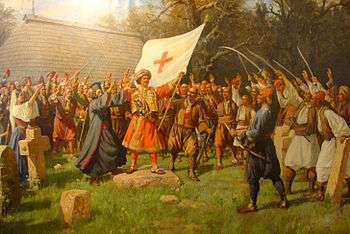Krstaš-barjak
The krstaš-barjak (crusader flag) (Serbian Cyrillic: крсташ-барјак; from krst, "cross" and barjak, "flag, banner")[a] refers to various war flags with crosses in the centre, part of Serbian tradition,[1] originating from medieval military flags.[2] It is known that Serbian Emperor Stefan Dušan (r. 1331–55) adopted the Byzantine cross flag[3] (divellion, which was purple and had a golden cross in the center).[4] According to Serbian epic poetry, during the Ottoman period, hajduks had war flags with crosses (krstaš-barjak) or icons of saints (svetački barjak).[5] The krstaš-barjak is mentioned in poems of the Kosovo Cycle;[6][7] knight Boško Jugović bears it at the battle of Kosovo (1389).[8] It was used as the general rebel flag during the Serbian Revolution (1804–17), and as the secondary flag of the supreme commander (Karađorđe 1804–13; Miloš Obrenović 1815–17).
[3] It was adopted as a military flag by the Principality of Montenegro (1852–1910) and Kingdom of Montenegro (1910–1918).[9] The Montenegrin war flag used in the Battle of Vučji Do (1876) was red with a white cross pattée in the center and a white border, and tradition holds that it was adopted from the war flag of Kosovo which found itself in Montenegro after surviving knights brought it there.[10] In Peroj (in Croatia), it is held that their ancestors (who migrated from Montenegro) had a war flag used at Kosovo in their possession.[11]
 The Takovo Uprising (1888), Miloš Obrenović initiating the Second Serbian Uprising (1815–17).
The Takovo Uprising (1888), Miloš Obrenović initiating the Second Serbian Uprising (1815–17). Actual bullet-ridden war flag from the Montenegrin–Ottoman Battle of Vučji Do (1876).
Actual bullet-ridden war flag from the Montenegrin–Ottoman Battle of Vučji Do (1876).
See also
Annotations
- ^ In Serbian linguist Vuk Karadžić's 1818 dictionary, the krstaš-barjak is translated as German: Die Kreuzfahne and Latin: vexillum cruciatum.[12]
References
- NIN: nedeljne informativne novine. Politika. 2007. p. 44.
- Stanojević, Stanoje (1934). Iz naše prošlosti. Geca Kon. p. 83.
- Kostić, Lazo M. (1960). O zastavama kod Srba: istoriska razmatranja. Munich.
- Milićević, Milić (1995). Grb Srbije: razvoj kroz istoriju. Službeni Glasnik. p. 22.
- Vojni muzej JNA (1954). Vesnik. 1–3. Belgrade: Vojni muzej JNA. p. 141.
- Zora (1937). "Narodna odbrana". 12. Zora: 212. Cite journal requires
|journal=(help) - Đurić, Vojislav (1954). Narodne junačke pesme najstarijih vremena: Pretkosovske i kosovske. Znanje. p. 128.
- Rootham, Helen (1 January 2010). Kossovo: Heroic Songs of the Serbs. Cosimo, Inc. p. 34. ISBN 978-1-61640-436-9.
- Markuš, Jovan B. (2007). Grbovi, zastave i himne u istoriji Crne Gore. Svetigora. p. 73.
- Ivanović, Filip (2006). "Problematika autokefalije Mitropolije Crnogorsko-primorske". Unireks: 93. Cite journal requires
|journal=(help) - Barjaktarević, Mirko (1991). Reljić, Ljubomir (ed.). O poistovećivanju verske i nacionalne pripadnosti. Гласник Етнографског музеја у Београду. Etnografski muzej u Beogradu. p. 259.
- Karadžić, Vuk (1818). Српски рjечник, истолкован њемачким и латинским риjечма. p. 248.